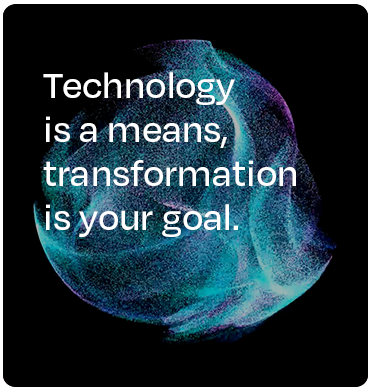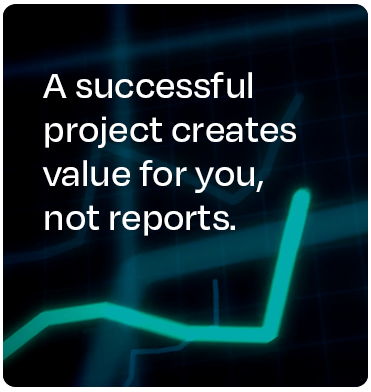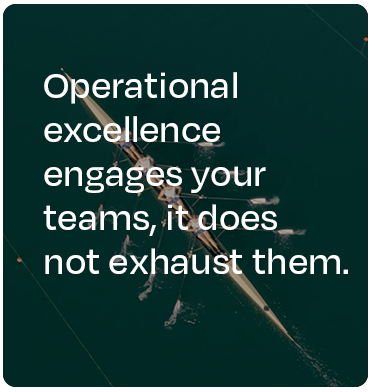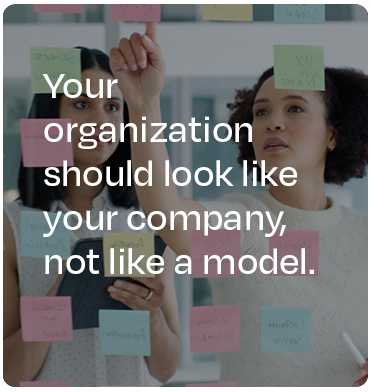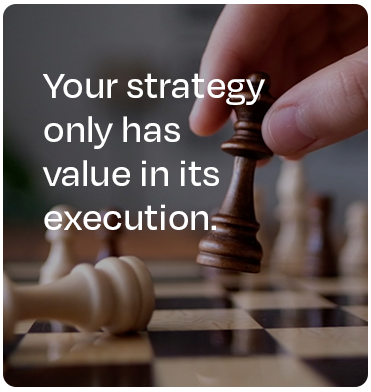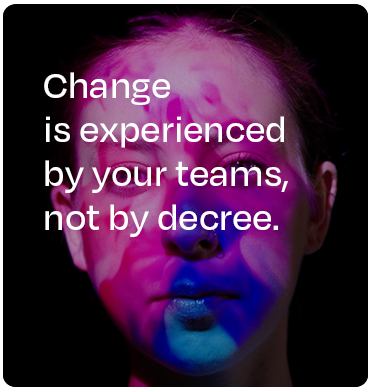87% of digital transformations fail.
Why? Because 99% of companies do it backwards. They buy the technology first, then try to force transformation around it. The result: wasted millions, digitized problems instead of solved ones, and widespread frustration.
Our method reverses this logic: we first transform practices and processes to create value, THEN select the right technology to amplify that success.
Proof through impact: our method in action

The challenge:
A distribution company was failing the multi-million rollout of a new ERP. The project was delayed, and most importantly, future users rejected the tool because it didn’t align with their work processes.
Our action (transformation-first):
We paused the technical deployment to focus on what mattered most: process transformation. Together with frontline teams, we redesigned workflows before configuring the ERP to serve these optimized processes.
The result:
After relaunch, ERP adoption reached 85% within 3 months. The final budget was 20% lower than estimated, since only features that created real business value were developed.
Methodology
Our 4-phase approach: People first, tech as a value enabler
Phase 1 : Strategic alignment & field diagnosis
Clarify the why before the how.
We start from your brief to define the true strategic objective, then immerse ourselves in the field to identify real problems and quantify their value.
- Co-definition of the strategic objective: Challenging the initial request to uncover the real business issue.
- Field immersion: Identifying the actual problems holding back performance.
- Value qualification: Quantifying potential gains, aligned with your organization’s cultural maturity.
→ Deliverable: A validated strategic objective and a prioritized, realistic value map.
Phase 2 : Co-building the target & quick wins
From opportunity to tangible solution.
Based on the identified value opportunities, we run workshops with your teams to co-design the target (processes, practices) and identify the first quick wins.
- Co-design workshops: Teams redesign workflows and journeys to solve the problems identified in Phase 1.
- Identification of quick wins: Prioritization of high-impact, low-effort actions (simplifying processes, organizational adjustments, simple tools) to generate momentum.
- Mobilization through action: By becoming authors of the solution, teams take ownership of change from the start.
→ Deliverable: A co-designed target and a validated pilot roadmap.
Phase 3 : Specification & technology selection
From validated needs to the right tool.
We translate validated team needs into a focused requirements document. On this solid basis, we run the selection process to identify the most relevant technology.
- Needs formalization: Drafting an RFP based on evidence and practices defined in Phase 2.
- Technology selection: Identifying the 20% of tech that generates 80% of the impact, prioritizing simplicity and fit to actual needs.
- POC (Proof of Concept): Validating the chosen solution on a limited scope with clear success metrics.
→ Deliverable: A validated requirements document, the choice of technology, and a deployment business case.
Phase 4 : Deployment management & ROI measurement
Technology accelerates an already successful transformation.
As business-side project advisors, we manage deployment to ensure that technology truly drives adoption and business impact.
- Progressive rollout with rapid feedback loops from the field.
- Training focused on usage and benefits, not on tool features.
- Rigorous measurement of adoption and business impact to calculate the final ROI.
→ Deliverable: A successful digital transformation with high adoption and proven ROI.
The Ad Valoris Difference
What sets us apart
| Classic “Tech-First” Approach | “Human-First Transformation™” approach |
|---|---|
| Technology first | L’objectif poursuivi d’abord/td> |
| Requirements based on assumptions | Requirements based on evidence |
| Large, risky upfront investment | Progressive, secured investment |
| Low adoption (<20%) | High adoption (>70%) |
| ROI rarely measured | Proven and maximized ROI |
The questions your peers are asking
Isn’t it risky to avoid talking about technology in Phase 1 if there’s a technical deadline?
How can you guarantee that teams really adopt the transformation?
If we transform processes before choosing the tool, don’t we risk redoing everything once the tool is selected?
My CIO/CTO wants to see technical solutions quickly. How do we handle that pressure?
In Phase 3, we provide a requirements document based not on assumptions but on real, validated needs from the field—prioritized by business value. This guarantees the right tool selection and avoids costly projects with low adoption.
